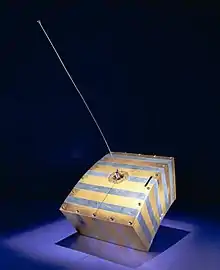| Mission type | Amateur Radio Satellite |
|---|---|
| Operator | AMSAT |
| COSPAR ID | 1978-026B[1] |
| SATCAT no. | 10703 |
| Spacecraft properties | |
| Launch mass | 27.2 kilograms (60 lb) |
| Dimensions | 38 cm × 38 cm × 33 cm (15 in × 15 in × 13 in) |
| Power | 15 W |
| Start of mission | |
| Launch date | 5 March 1978, 17:54 UTC |
| Rocket | Delta-2910 139 |
| Launch site | Vandenberg SLC-2W |
| End of mission | |
| Last contact | 24 June 1983 |
| Orbital parameters | |
| Reference system | Geocentric |
| Regime | Low Earth |
| Semi-major axis | 7,274.0 km (4,519.9 mi) |
| Perigee altitude | 899.1 km (558.7 mi) |
| Apogee altitude | 907.8 km (564.1 mi) |
| Inclination | 99.0291° |
| Period | 102.9 minutes |
| Epoch | 6 February 2020[2] |
OSCAR 8 (also called AO-08, Phase 2D or Amsat P2D) is an American amateur radio satellite. It was developed and built by radio amateurs of the AMSAT and launched on March 5, 1978 as a secondary payload together with the Earth observation satellite Landsat 3 from Vandenberg Air Force Base, California, United States.
The satellite had two linear transponders, from the 2-meter band (uplink) to the 10-meter band and the 70-centimeter band (downlink).
Frequencies
Transponder 1
Transponder 2
- Uplink (MHz): 145.900 - 146.000
- Downlink (MHz): 435.200 - 435.100
- Beacon (MHz): 435.095
- Mode: SSB CW
References
This article is issued from Wikipedia. The text is licensed under Creative Commons - Attribution - Sharealike. Additional terms may apply for the media files.
